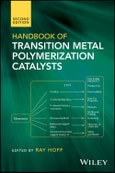- Contains the valuable data needed to reproduce syntheses or use the catalyst for new applications
- Offers a guide to the design and synthesis of catalysts, and their applications in synthesis of polymers
- Includes the information essential for choosing the appropriate reactions to maximize yield of polymer synthesized
- Presents new chapters on vanadium catalysts, Ziegler catalysts, laboratory homopolymerization, and copolymerization
Table of Contents
Notes on Contributors xvii
Preface xxix
Acknowledgments xxxiii
1 Industrial Metal Alkyls and Their Use in Polyolefin Catalysts 1
Dennis B. Malpass
1.1 Introduction 1
1.2 Metal Alkyls in Ziegler–Natta Catalysts 2
1.3 Aluminum Alkyls 4
1.4 Manufacturers of Aluminum Alkyls 10
1.5 Pricing and Selection Criteria for Aluminum Alkyls 11
1.6 Methylaluminoxanes 13
1.7 Magnesium Alkyls 18
1.8 Organoboron Compounds 24
1.9 Organozinc Compounds 26
References 27
2 Porous Silica in Transition Metal Polymerization Catalysts 31
Thomas J. Pullukat and Robert E. Patterson
2.1 Introduction 31
2.2 Production of Silica Gel Catalysts 33
2.3 Influence of Silica Gel Properties and Polymerization Conditions on Catalyst Performance 36
2.4 Conclusions 52
References 53
3 Activator Supports for Metallocene and Related Catalysts 57
Ray Hoff
3.1 Introduction 57
3.2 Activator Support Studies 58
3.3 Activator Support Patents 60
3.4 Conclusion 62
References 64
4 Computational Modeling of Polymerization Catalysts 67
Monika Srebro Hooper and Artur Michalak
4.1 Introduction 67
4.2 Computational Modeling of Chemical Reactions 68
4.3 Modeling the Catalyst Properties and the Polymerization Processes 76
4.4 Concluding Remarks 116
Acknowledgment 117
References 117
5 Computational Studies of Chromium: Silica Catalysts 131
Zhen Liu and Boping Liu
5.1 Introduction 131
5.2 Mechanistic Proposals for Phillips Catalyst 132
5.3 Theoretical Study on Phillips Catalyst 137
5.4 The Limitation of the Current Computations and a Prospect for the Future 156
References 157
6 Laboratory Reactors and Procedures for Catalyst Evaluation 161
Rinaldo Schiffino
6.1 Introduction 161
6.2 Setup in the Fume Hood 162
6.3 Autoclave Reactors and Safety Relief Devices 163
6.4 Purification Methods 164
6.5 Modular Reactor System 165
6.6 Catalyst Addition 168
6.7 Temperature Control 170
6.8 Autoclave Reactor Setup 172
6.9 Copolymerization 173
6.10 GasÂ-Phase Laboratory Reactors 175
References 176
7 ScaleÂ-Up of Catalyst Recipes to Commercial Production 177
Chung Ping Cheng
7.1 Introduction 177
7.2 Fundamental of Process ScaleÂ-Up 178
7.3 Considerations in Scaling Up a Laboratory Recipe 180
7.4 A Modern Polymerization Catalyst Production Facility 182
7.5 Other ScaleÂ-Up Considerations 187
References 187
8 Supported Titanium/Magnesium Ziegler Catalysts for the Production of Polyethylene 189
Yury V. Kissin, Thomas E. Nowlin, and Robert I. Mink
8.1 Introduction 189
8.2 ParticleÂ-Form Technology 192
8.3 General Architecture and Preparation of Supported Catalysts 193
8.4 Nonuniformity of Active Centers in Supported Ziegler Catalysts 205
8.5 Kinetics and Mechanism of Ethylene Polymerization Reactions with Ziegler Catalysts 209
8.6 Kinetic Interpretation of Ethylene Polymerization Reactions 217
8.7 Active Centers in Ziegler Catalysts 221
References 224
9 Stereospecific αÂ-Olefin Polymerization with Heterogeneous Catalysts 229
John Severn and Robert L. Jones, JR
9.1 Introduction 229
9.2 Traditional Ziegler–Natta Catalyst Systems 241
9.3 Stereospecific Single Site Catalysts 266
9.4 Conclusion 295
References 296
10 Olefin Polymerization by Vanadium Complex Catalysts 313
Kotohiro Nomura and Xiaohua Hou
10.1 Introduction: Classical ZieglerÂ-Type Vanadium Catalyst Systems 313
10.2 Vanadium Complexes Designed for Olefin Coordination Insertion Polymerization 315
10.3 Outlook 332
References 333
11 MgCl2Â-Supported Ti Catalysts for the Production of MorphologyÂ-Controlled Polyethylene 339
Long Wu and Sieghard Wanke
11.1 Introduction 339
11.2 Preparation of MorphologyÂ-Controlled MgCl2/TiCl4 Catalysts 342
11.3 Polymerization Processes 345
11.4 Effect of Prepolymerization on Activity Profiles and Prepolymer Properties 349
11.5 Polymerization Behavior 358
11.6 Summary and Conclusions 364
References 365
12 Product Morphology in Olefin Polymerization with PolymerÂ-Supported Metallocene Catalysts 369
Long Wu and Sieghard Wanke
12.1 Introduction 369
12.2 Preparation of PolymerÂ-Supported Metallocene Catalysts 371
12.3 Factors Affecting Morphology of Product Particles 379
12.4 Factors Affecting Product Morphology 389
12.5 Product Fines and Densities 394
12.6 Conclusions 396
References 396
13 A Review of the Phillips Chromium Catalyst for Ethylene Polymerization 401
Max P. McDaniel
13.1 Historical and Commercial Background 401
13.2 Catalyst Preparation 404
13.3 Control of Catalyst Activity 414
13.4 Control of Molecular Weight and MW Distribution 439
13.5 Control of Crystallinity 482
13.6 Control of Elasticity 509
13.7 Concluding Remarks 542
References 546
14 SilicaÂ-Supported Silyl ChromateÂ-Based Ethylene Polymerization Catalysts 573
Kevin Cann
14.1 Introduction 573
14.2 Silyl Chromate Catalyst Development 573
14.3 Catalyst Structure 575
14.4 Polymerization Process 578
14.5 Product Characterization and Applications 579
14.6 SilicaÂ-Supported Reduced Silyl Chromate Catalyst Advancements 582
Acknowledgements 588
References 588
15 Late Transition Metal Catalyzed CoÂ- and Terpolymerization of αÂ-Olefins with Carbon Monoxide: Synthesis and Modification 591
Timo M. J. Anselment, Manuela Zintl, Maria Leute, Rüdiger Nowack, and Bernhard Rieger
15.1 Introduction and Historical Overview 591
15.2 Polyketone Synthesis: General Concept and Mechanism 593
15.3 Influence of the Catalyst on the Polymer Structure in αÂ-Olefin/CO Copolymerization Reactions 599
15.4 Other Olefins for the Copolymerization with CO 610
15.5 Chemical Modification of Polyketones 616
References 618
16 Ethylene Polymerization and αÂ-Olefin Oligomerization Using Catalysts Derived from Phosphoranes and Ni(II) or Ni(0) Precursors 623
Scott Collins
16.1 Introduction 623
16.2 Starting Materials 626
References 629
17 Overview of RingÂ-Opening Metathesis Polymerizations (ROMP) and Acyclic Diene Metathesis (ADMET) Polymerizations with Selected Ruthenium and Molybdenum Complexes 631
Robert T. Mathers
17.1 Introduction 631
17.2 Ruthenium Catalysts 634
17.3 Molybdenum Complexes 646
17.4 Summary 651
References 651
18 Copolymerization of Ethylene with Conjugated Dienes 661
Islem Belaid, Vincent Monteil, and Christophe Boisson
18.1 Introduction 661
18.2 Conventional
Ziegler–Natta Catalysts 663
18.3 Group
4 Metallocene Systems 665
18.4 Group 4 PostÂ-metallocene Catalysts 670
18.5 Vanadium Bis(imino)pyridyl Catalysts 673
18.6 Group 8Â-, 9Â-, and 10Â-Based Catalysts 674
18.7 Rare Earth Catalysts 675
18.8 Conclusion 686
References 687
Appendix A: Pyrophoricity of Metal Alkyls 693
Dennis B. Malpass
Appendix B: Rheological Terms for Polymerization Catalyst Chemists 705
Gregory W. Kamykowski
Index 711








